 Mobile network benchmarking
Mobile network benchmarking The strategy of RATEL is to encourage further investments and development of telecommunications markets by fostering competition, cost-effectiveness and efficiency in mobile communications, as well as to provide subscribers with fair and unbiased information about the quality of service in the mobile networks in the Republic of Serbia. Therefore, RATEL carried out the extensive benchmarking tests of the three mobile network operators: Telekom Srbija, Telenor and Vip mobile.This is the second year in a row that RATEL performs nationwide benchmarking. This year, walk tests and railway tests were included in the scope.
The purpose of Mobile Network Benchmarking is to compare in an objective fashion the quality of mobile network services by measuring Key Performance Indicators (KPIs) which represent user experience of services offered by all mobile network operators. The benchmarking measurements were conducted in September and October 2018. In the first half of 2018, RATEL conducted a public international tender for Mobile Network Benchmarking activity and awarded a contract to a consortium comprised of CRONY, a Serbian company specialized in the representation of foreign companies in Serbia and Systemics-PAB, a renowned services company from Poland.
Systemics-PAB is a well-recognized company offering benchmarking services to regulatory authorities and network operators worldwide. They provide solutions and services to measure, monitor and analyse the quality of mobile and fixed networks, with the aim to enhance the end-user experience. The experience Systemics-PAB gained in more than 10 years of working in this area, has enabled them to develop effective techniques and methodologies for conducting the benchmark activities, and all their tests, measurements and processes overall are ISO 9001 certified, which ensures impartiality and reliability of the results.
The rating and benchmarking of mobile services is done by using Systemics-PAB own scoring methodology that allows objective assessment of Quality of Service and user experience for each mobile network operator.
Benchmarking measurements covered 47 cities and 10,000 km of Serbian roads. During the campaign, over 6,000 voice calls and 100,000 data sessions were performed for each mobile network operator across all technologies (2G, 3G, 4G). These measurements included:
The whole benchmarking campaign was divided into phases as presented in Figure 1.
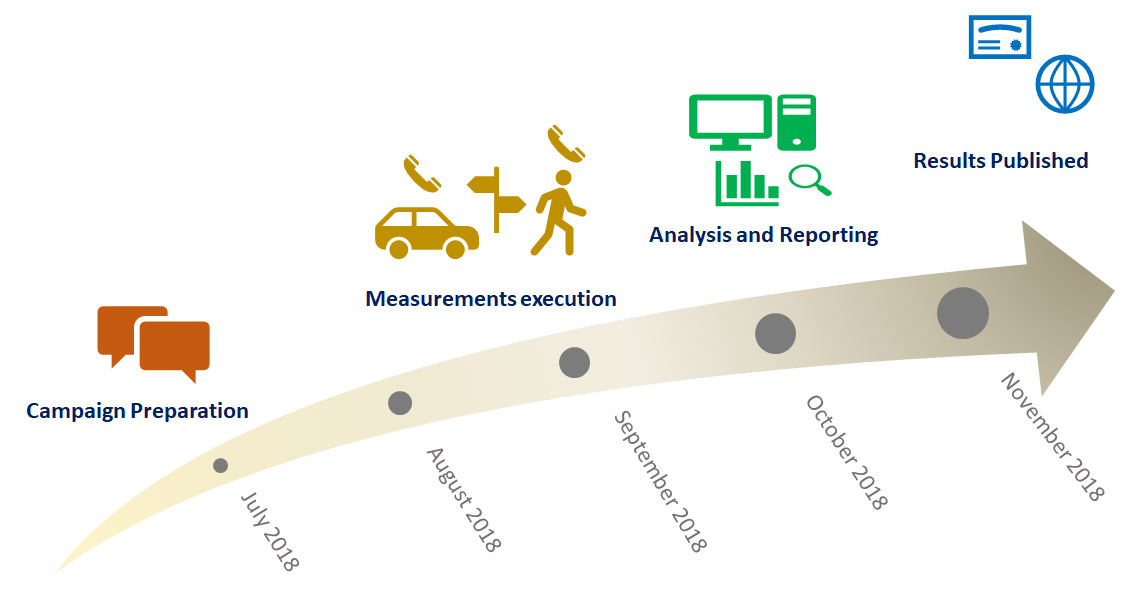
Fig.1 Benchmarking campaign phases
In parallel with analysis and reporting, a dedicated portal was updated with new results to enable the broad public viewing of benchmarking results on RATEL’s web page. The portal was also improved with new features.
In 2017, the largest share in total revenues of 58.5% in the Serbian electronic communications market, as in previous years, was achieved by providing mobile telephony services. (Source: An overview of the Telecom and Postal Services Market in the Republic of Serbia in 2017, RATEL).
The mobile market in Serbia, in terms of number of subscribers, is divided among three mobile network operators (MNO). Respective mobile subscribers’ shares are presented in Figure 2. Figure 3 presents the mobile market share in Serbia in terms of revenues generated by the operators.
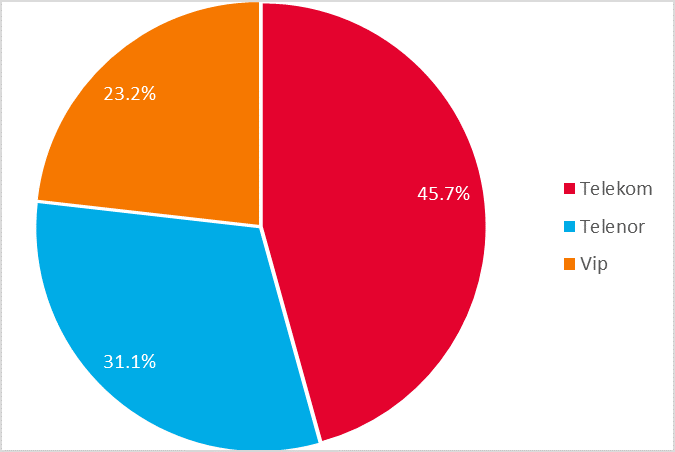
Fig. 2 Mobile subscribers
Source: 2017 Market Overview, RATEL
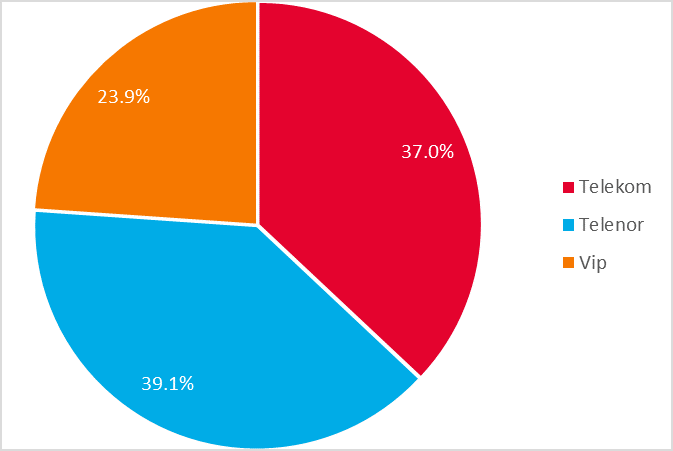
Fig. 3. Mobile Market revenue share
Source: 2017 market Overview, RATEL
The number of mobile subscribers in Serbia is approximately 8.48 million, which corresponds to 122% of SIM penetration. The voice users generated more than 4.14 billion minutes in the second quarter of 2018. Close to 62% of the voice traffic was on-net traffic. 5.6 million of subscribers were active mobile broadband subscribers generating over 47 million GB of data traffic in the Q2 2018. (Source: An overview of telecom market 2018 – Q2, RATEL)
With approximately 3.9 million subscribers, Telekom Srbija - MTS is the mobile network operator with the greatest number of subscribers in Serbia. It was founded in 1997 and started to provide mobile communications service in 1998. Telekom Srbija operates its 4G network at 800 MHz and 1800 MHz. Additionally, it operates a 3G network at 900 MHz and 2100 MHz and a 2G network at 900 MHz.
Telenor has been presented in Serbia since 2006, when they bought Mobi63, a former Mobtel that was founded in 1994. Since March 2018, Telenor is owned by PPF investment fund. It has 2.7 million subscribers. Telenor operates its 4G network at 800 MHz and 1800 MHz. It operates its 3G network mainly at 900 MHz, with limited additional 2100 MHz coverage, and its 2G network at 900 MHz and 1800 MHz.
Vip mobile was established in 2006 and is part of Telekom Austria Group. It has around 2 million subscribers. Vip mobile offers 4G network at 800 MHz and 1800 MHz, 3G network at 2100 MHz and 2G network at 900 MHz and 1800 MHz.
Telekom Srbija has the largest number of locations with active base stations in Q3 2018 as presented in Figure 4. (Source: RATEL data for Q3 2018, RATEL)
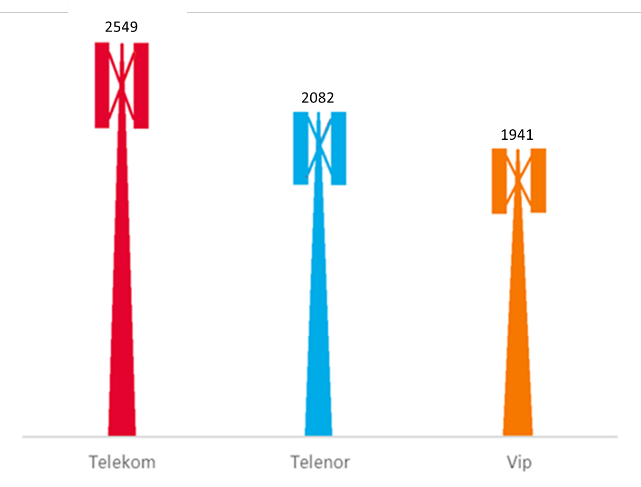
Fig. 4. Total number of locations with active base stations, per operator, Q3 2018
The total number of active base stations per mobile operator until Q3 2018, is presented in Figure 5. (Source: An overview of the telecom market 2017, RATEL and RATEL data for Q3 2018)
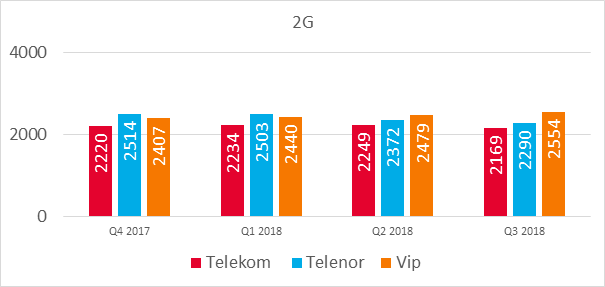
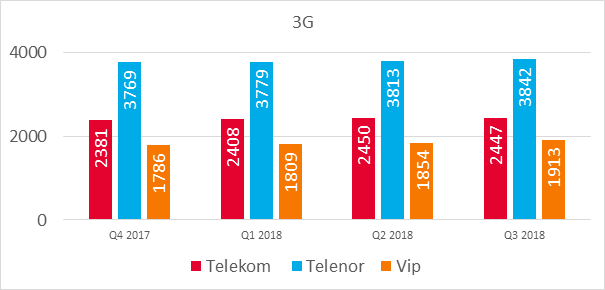
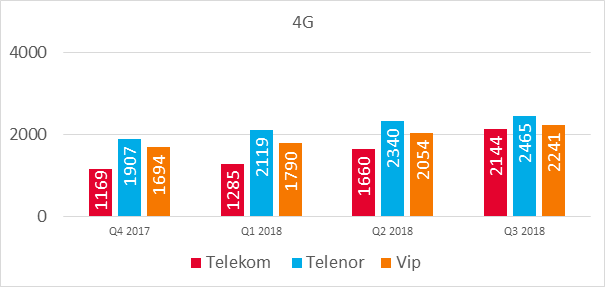
Fig. 5. Total number of active base stations per technology and mobile operator until Q3 2018